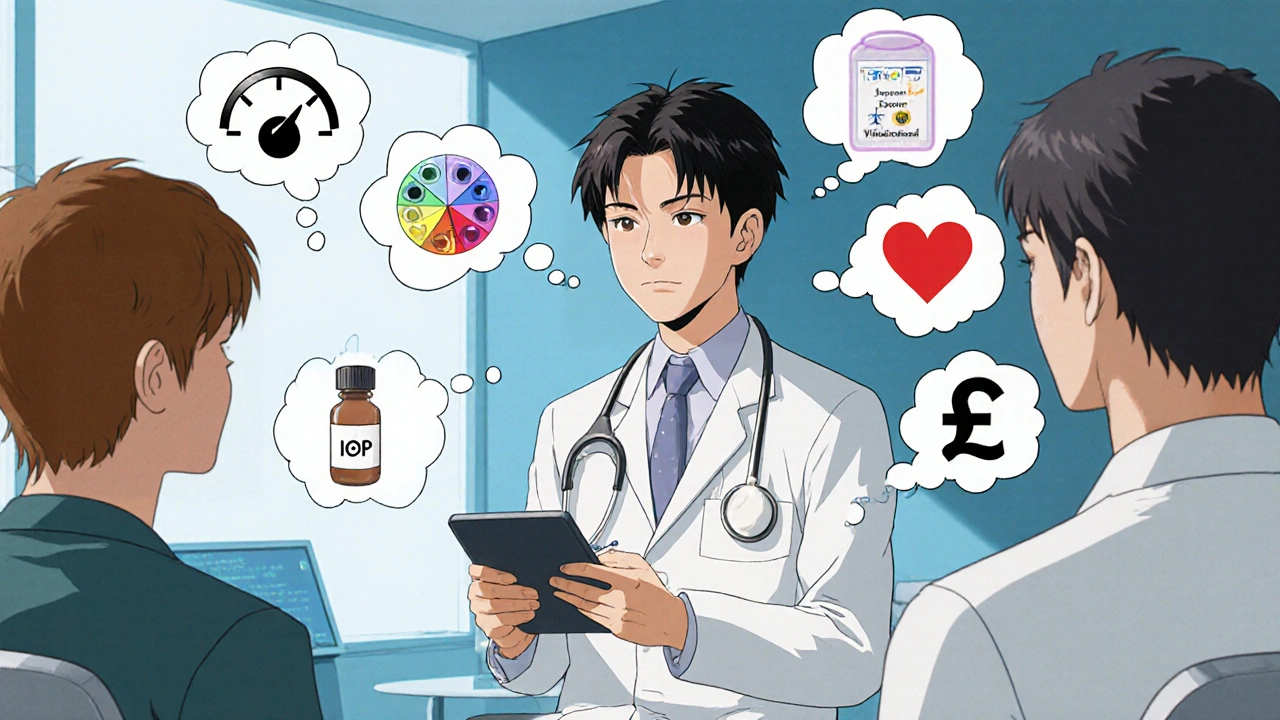Glaucoma Eye Drop Selector
Find Your Best Glaucoma Eye Drop
Answer a few questions about your situation to get personalized recommendations for glaucoma eye drops that match your needs.
Recommended Options
Key considerations: Based on your inputs, the best options minimize your concerns while providing effective IOP control.
Quick Takeaways
- Lumigan (Bimatoprost) is a prostaglandin analog that lowers intraocular pressure (IOP) more effectively than many older eye drops.
- Latanoprost and Travoprost offer similar IOP reduction with slightly lower rates of darkening of the iris.
- Brimonidine works via a different pathway (alpha‑2 agonist) and can be combined with prostaglandins for additive effect.
- Dorzolamide and Timolol are useful when patients can’t tolerate prostaglandins or need additional pressure control.
- Cost, preservative type, and side‑effect profile often decide which alternative fits a patient best.
What is Lumigan (Bimatoprost)?
When building a treatment plan for glaucoma, Lumigan is a prostaglandin‑F2α analog marketed as Bimatoprost 0.01% eye drops. It works by increasing the outflow of aqueous humor through both the conventional trabecular meshwork and the uveoscleral pathway, leading to a 25‑30% drop in intraocular pressure (IOP) after a single dose.
Approved by the FDA in 2001, Lumigan quickly became a first‑line option for primary open‑angle glaucoma (POAG) and ocular hypertension. Its once‑daily dosing and strong IOP‑lowering effect make it attractive, but it also carries a few distinct side‑effects such as iris darkening and eyelash growth.
How does Bimatoprost lower eye pressure?
Bimatoprost mimics the natural prostaglandin F2α molecule. By binding to FP receptors in the ciliary body, it relaxes the extracellular matrix, widening the spaces through which aqueous humor exits the eye. This dual‑route enhancement distinguishes it from older agents that rely on a single pathway.
Common alternatives to Lumigan
Below are the most frequently prescribed eye drops that compete with Lumigan in the market. Each belongs to a different drug class, offering clinicians multiple mechanisms to hit the target IOP.
Prostaglandin analogs
Latanoprost is a 0.005% prostaglandin analog that primarily enhances uveoscleral outflow. It reduces IOP by about 25% and is often chosen for its lower cost.
Travoprost is a 0.004% prostaglandin analog similar to Latanoprost but with a slightly higher potency in some patients. A preservative‑free formulation (Travatan Z) is available for those sensitive to benzalkonium chloride.
Tafluprost is a 0.0015% prostaglandin analog marketed as a preservative‑free single‑dose unit. Its efficacy matches Lumigan in many head‑to‑head trials while causing fewer cosmetic changes.
Alpha‑2 adrenergic agonist
Brimonidine is a 0.2% eye drop that reduces aqueous humor production and increases uveoscleral outflow via alpha‑2 receptors. It lowers IOP by 15‑20% and can be combined with a prostaglandin for additive effect.
Carbonic anhydrase inhibitor
Dorzolamide is a 2% topical carbonic anhydrase inhibitor that decreases aqueous humor formation. It’s typically used twice daily and works well when prostaglandins cause intolerable side‑effects.
Beta‑blocker
Timolol is a non‑selective beta‑adrenergic antagonist that cuts aqueous production. It can be combined with any of the above classes but is contraindicated in patients with asthma or severe heart block.
Head‑to‑head comparison
| Drug | Mechanism | Avg. IOP reduction | Main side‑effects | Typical cost (UK, per month) |
|---|---|---|---|---|
| Lumigan (Bimatoprost) | Prostaglandin analog (dual‑pathway) | 25‑30% | Iris darkening, eyelash growth, conjunctival hyperemia | £30‑£45 |
| Latanoprost | Prostaglandin analog (uveoscleral) | 22‑26% | Mild hyperemia, occasional iris darkening | £15‑£25 |
| Travoprost | Prostaglandin analog (uveoscleral) | 23‑27% | Hyperemia, less iris change than Lumigan | £20‑£30 |
| Tafluprost | Prostaglandin analog (ureoscleral, preservative‑free) | 24‑28% | Minimal cosmetic changes, rare hyperemia | £35‑£50 |
| Brimonidine | Alpha‑2 agonist | 15‑20% | Dry eye, allergic conjunctivitis, fatigue | £12‑£20 |
| Dorzolamide | Carbonic anhydrase inhibitor | 15‑18% | Metallic taste, stinging, rare sulfa allergy | £10‑£18 |
| Timolol | Beta‑blocker | 20‑25% | Bronchospasm risk, bradycardia, dry eye | £8‑£15 |
Choosing the right eye‑drop for you
- Severity of IOP elevation: For high baseline pressures, the strongest agents (Lumigan, Tafluprost) are often first‑line.
- Cosmetic concerns: If iris darkening or eyelash growth is a deal‑breaker, Latanoprost, Tafluprost or preservative‑free Travoprost are better choices.
- Allergy or preservative sensitivity: Opt for preservative‑free formulations (Travoprost Z, Tafluprost) or switch to a non‑prostaglandin class.
- Systemic comorbidities: Avoid beta‑blockers like Timolol in asthma or COPD; choose Brimonidine or a prostaglandin instead.
- Cost and insurance coverage: Generic latanoprost or dorzolamide are usually cheapest; check NHS formularies for exemptions.
Safety, side‑effects and monitoring
All glaucoma drops require regular follow‑up. Measure IOP at baseline, 4‑6 weeks after initiation, then every 3‑6 months. Look for:
- Conjunctival hyperemia (red eye)
- Changes in iris color - more common with prostaglandins
- Periorbital fat atrophy (rare, seen long‑term with prostaglandins)
- Systemic effects - bradycardia with beta‑blockers, bronchospasm with timolol, fatigue with brimonidine.
If side‑effects become troublesome, discuss switching to a preservative‑free version or to a different drug class.

Cost and availability in the UK
Most prostaglandin analogs are prescription‑only meds dispensed through NHS or private pharmacies. Generic latanoprost is widely covered by the NHS, while brand‑name Lumigan may require a private prescription for the full dosage. Some patients qualify for the NHS "glaucoma drug scheme" that subsidises the cost of any first‑line prostaglandin.
Key takeaways for clinicians
- Start with the most potent prostaglandin (Lumigan or Tafluprost) unless cosmetic side‑effects are a concern.
- Consider combination therapy early if IOP remains > 18 mmHg after monotherapy.
- Preservative‑free options reduce ocular surface disease in dry‑eye patients.
- Always screen for systemic contraindications before prescribing beta‑blockers or alpha‑agonists.
Frequently Asked Questions
Can I use Lumigan and Latanoprost together?
No. Both are prostaglandin analogs that work via the same pathway, so combining them offers no extra IOP drop and only raises the risk of side‑effects.
Why does my eye turn brown after using Lumigan?
The prostaglandin stimulates melanocytes in the iris, gradually increasing pigment. The change is usually permanent but harmless.
Are preservative‑free eye drops better for dry eyes?
Yes. Benzalkonium chloride, the common preservative, can disrupt the tear film. Preservative‑free formulations like Travoprost Z or Tafluprost single‑dose units are gentler on the ocular surface.
Can I switch from Timolol to a prostaglandin without a wash‑out period?
A direct switch is fine. Beta‑blockers wear off quickly, so patients can start the prostaglandin the next day. Monitor IOP closely during the first two weeks.
Is there any benefit to using Dorzolamide at night?
Night‑time dosing can help control the early‑morning IOP spike that some patients experience. It's a common adjunct to a once‑daily prostaglandin.






